FAQs
Erste Schritte - Grundlegende Informationen für Erstkäufer
Beginnen Sie mit einem Gyuto (Kochmesser), wenn Sie eine Allzweckklinge wünschen; seine sanfte Krümmung macht das Schneiden von Fleisch, Fisch und Gemüse zum Kinderspiel. Für eine kleinere Variante empfiehlt sich ein Santoku (19 cm), das von Frauen und Benutzern mit kleineren Händen oft als wendiger empfunden wird.
Weitere Informationen hier und hier.
Japanische Klingen sind dünner und härter (AUS-10 HRC ≈ 62), so dass sie länger scharf bleiben, aber nur für weiche Bretter und niemals für Knochen oder gefrorene Lebensmittel verwendet werden dürfen.
Nein. Sie können als Gast zur Kasse gehen, aber wenn Sie ein Konto anlegen, können Sie Ihre Bestellungen verfolgen, Rechnungen mit Mehrwertsteuer herunterladen und Liefertermine vormerken.
Die Kartendaten werden auf einer PCI-DSS-konformen HTTPS-Seite erfasst; Oishya speichert niemals Ihre Kartennummer und behält nur eine tokenisierte Referenz für Erneuerungen.
Alle Produkte werden ausschließlich auf oishya.com verkauft, um die Preise an der handwerklichen Qualität auszurichten und Aufschläge von Zwischenhändlern zu vermeiden.
Absolutely, and many of our customers do exactly this. There’s no requirement to stay within one line, and mixing can give you the best of each collection. A common combination is a KATA or RYU Gyuto as your everyday workhorse, paired with a SHIN Petty for precision tasks where you want that extra edge retention. Some customers choose RYU for the Damascus beauty in their main knives, then add PAN for bread. Others build around performance, starting with SHIN, then adding NIJI for the sheer artistry of it.
All our handles are crafted from the same premium stabilised maple burl wood in the same three beautiful colours (Natural Brown, Mediterranean Blue, and Olive Green). The handle shape, size, and construction are consistent across all lines. This means that whether you display a KYU Gyuto alongside a SHIN Petty and a NIJI Nakiri, they’ll look stunning together – like a cohesive collection rather than a mismatched assortment. The blades may showcase different patterns and finishes, but the handles create visual harmony.
Each line complements the others beautifully, and building a mixed collection lets you choose the perfect knife for each specific need whilst creating a collection that reflects your personal taste and looks gorgeous on your magnetic rack or in your knife block.
Bestellung & Bezahlung
| Akzeptierte Methoden | Visa, MasterCard, PayPal (3,5% Gebühr) |
| Bearbeitungszeit | Vorrätige Bestellungen werden innerhalb von 1-3 Arbeitsstunden nach Zahlungseingang versandt |
| Ändern oder stornieren | E-Mail an info@oishya.com innerhalb einer Stunde; nach dem Versand gilt das Rückgaberecht |
| Geschenk-Serviceleistungen | Sakai Kyuba- und Seki Kyuba-Messer können mit einer kostenlosen Gravur versehen werden; fügen Sie Ihren Wunsch in den Anmerkungen an der Kasse hinzu oder senden Sie uns bei der Bestellung eine E-Mail. |
The Gyuto is essentially a Japanese interpretation of the Western chef’s knife. It has a curved belly that allows for a rocking motion when chopping herbs, a pointed tip for precision work, and enough length to handle large ingredients. It’s the most versatile knife in any kitchen and feels familiar if you’re transitioning from Western knives.
The Santoku is distinctly Japanese – its name literally means “three virtues,” referring to its excellence with meat, fish, and vegetables. The blade profile is flatter than a Gyuto with less curve, and it has a sheep’s foot tip (rounded rather than pointed). This design is brilliant for push-cutting and up-down chopping without the rocking motion. Many people find it easier to control, especially in compact kitchens.
The Bunka features a distinctive K-tip (reverse tanto point) – an angled, partially flat tip that looks striking and offers excellent control for detailed work. The blade profile is similar to a Santoku but with that unique tip. It’s become increasingly popular for its combination of functionality and aesthetic appeal, and it’s particularly good when you need precision with the tip of the knife.
The Nakiri is a specialist vegetable knife with a completely flat edge – no curve whatsoever. This makes it perfect for push-cutting straight down through vegetables, and the tall blade gives excellent knuckle clearance. If you do a lot of vegetable prep, particularly fine julienne, precise dice, or Japanese-style cutting, a Nakiri is transformative. It’s also brilliant for anyone who wants to improve their knife skills because it naturally encourages proper push-cutting technique.
The Santoku, whilst excellent with vegetables, is more of a generalist. It has a slight curve that allows some rocking motion, and it handles meat and fish just as well as vegetables. If you can only have one knife, the Santoku is more versatile. But for anyone who loves cooking vegetable-forward meals or wants to experience how Japanese chefs prepare vegetables, a Nakiri is a revelation.
Many of our customers end up with both – Santoku for everyday versatility, Nakiri for those times when vegetables are the star of the meal.
A knife is too large if the tip hangs off your cutting board when you’re working, if you feel you don’t have full control over it, or if your wrist gets tired quickly. It’s too small if you can’t cut through larger vegetables in a single stroke, if you need multiple passes for basic tasks, or if you feel cramped during prep.
Here’s a useful tip: most people overestimate the size they need. A 21cm Gyuto can handle an astonishing range of tasks, and the extra manoeuvrability compared to a 24cm knife often makes kitchen work more enjoyable. When in doubt, go slightly smaller – you can always add a larger knife later if you find you need it.
Versand & Lieferung
Ja, wir bieten kostenlosen Versand in Großbritannien für Bestellungen über £90 und kostenlosen internationalen Versand für Bestellungen über £290. Bei schweren Paketen kann eine zusätzliche Gebühr an der Kasse anfallen, da wir die Pakete eventuell als Sonderversand versenden müssen. Details zum Versand finden Sie hier.
Nach dem Versand wird automatisch ein Link zur Sendungsverfolgung per E-Mail verschickt; Sie können Ihre Bestell-ID und Ihre Rechnungs-E-Mail auch auf der entsprechenden Seite zur Sendungsverfolgung eingeben. Wenn Sie den Link nicht erhalten haben, überprüfen Sie bitte Ihr Spam-Postfach. Wenn Sie immer noch nichts erhalten haben, kontaktieren Sie uns und wir senden Ihnen den Link gerne noch einmal zu.
Sie können Ihre Bestellung hier verfolgen.
Vorrätige Bestellungen können innerhalb von 1 Stunde nach Aufgabe während der Geschäftszeiten (Montag-Freitag, 9-18 Uhr GMT) geändert werden. Dazu gehören die Änderung der Lieferadresse, das Hinzufügen von Artikeln oder die Erweiterung der Versandoptionen. Nach Ablauf dieses Zeitfensters bearbeitet unser Abwicklungszentrum die Bestellung und versendet Ihr Paket, so dass Änderungen nicht mehr möglich sind.
Bestellungen, die im Rückstand sind, können innerhalb des Bearbeitungszeitfensters, das in der Bestätigungs-E-Mail angegeben ist, geändert werden.
Um eine Bestellung zu ändern, loggen Sie sich in Ihr Konto ein und besuchen Sie den Bereich “Meine Bestellungen”, oder senden Sie sofort eine E-Mail an info@oishya.com mit Ihrer Bestellnummer und den gewünschten Änderungen. Oishya Bei Stornierungen innerhalb des 1-Stunden-Fensters erfolgt die vollständige Rückerstattung innerhalb von 5-7 Werktagen auf die ursprüngliche Zahlungsmethode.
Bestellungen werden aus dem Vereinigten Königreich versandt. Kunden aus dem Vereinigten Königreich zahlen keine Zölle; Kunden aus der EU und der ganzen Welt sollten 20-25% des Bestellwerts für Mehrwertsteuer und Einfuhrgebühren einplanen, die an den örtlichen Zoll zu zahlen sind.
EU-Kunden: Möglicherweise können wir innerhalb der EU von unserer polnischen Werkstatt aus liefern – bitte senden Sie uns bei der Bestellung eine E-Mail.
Stabilisation is a process where wood is completely dried, placed in a vacuum chamber with resin, and the resin is drawn into every cell of the wood. The result is wood that won’t crack, warp, or absorb water, whilst retaining all its natural beauty.
We chose maple burl specifically because burls – those abnormal growths on trees – create the most stunning grain patterns. Every handle is unique, with swirling, three-dimensional figuring that makes each knife individual. The wood has perfect weight for balance, comfortable ergonomics, and when stabilised, it lasts generations.
The colours (Natural Brown, Mediterranean Blue, Olive Green) are created during stabilisation – the resin is dyed before penetrating the wood, so the colour goes throughout rather than being a surface coating. This means the handles won’t fade or wear unevenly over time.
Stabilised wood is remarkably low-maintenance. After using your knife, wipe the handle with a damp cloth and dry it completely before storage. Never soak the knife in water or put it in the dishwasher.
Every few months, if you’d like, you can wipe the handle with food-safe mineral oil or a wood conditioner. This isn’t strictly necessary with stabilised wood, but it does enhance the depth of the colour and grain. The process takes about 30 seconds – just apply a thin coat, let it sit for a minute, then buff off the excess.
That’s honestly it. The stabilisation process makes these handles far more durable than traditional wood, whilst keeping all the beauty and warmth of natural timber.
We chose maple burl specifically because burls – those abnormal growths on trees – create the most stunning grain patterns. Every handle is unique, with swirling, three-dimensional figuring that makes each knife individual. The wood has perfect weight for balance, comfortable ergonomics, and when stabilised, it lasts generations.
The colours (Natural Brown, Mediterranean Blue, Olive Green) are created during stabilisation – the resin is dyed before penetrating the wood, so the colour goes throughout rather than being a surface coating. This means the handles won’t fade or wear unevenly over time.
Yes, absolutely. When you order any knife (in any line except where specifically noted), you’ll select from Natural Brown, Mediterranean Blue, or Olive Green. All three colours are available across all knife types.
Natural Brown is classic and versatile, showing off the maple burl grain beautifully. Mediterranean Blue adds a striking, contemporary pop of colour that looks stunning against the steel. Olive Green offers sophisticated elegance and has become increasingly popular with customers who want something distinctive but not overly bold.
There’s no wrong choice – it’s entirely about your personal aesthetic preference and kitchen style
Japanische Küchenmesser 101
Bei so vielen Formen, Größen, Stählen, Oberflächen und Griffmaterialien ist es oft schwierig zu wissen, worauf man bei einem japanischen Messer achten muss. Aber die Wahl eines Küchenmessers und der richtigen Schärfwerkzeuge ist nicht so schwer, wie Sie vielleicht denken, es scheint nur so, weil es so viele Möglichkeiten gibt. Wir sind für Sie da, um das beste japanische Messer auszuwählen. Die Kosten und die Angst, etwas falsch zu machen, können stressig sein, aber da wir eine 100-Tage-Geld-zurück-Garantie anbieten, sind wir uns zu 100% sicher, dass Sie unsere Produkte lieben werden. Machen Sie unser schnelles Quiz, um Ihr perfektes Messer zu finden. Sie können auch unseren Leitfaden für den Kauf Ihres ersten japanischen Messers oder den Abschnitt “Japanische Messer” in unserem Journal lesen.
Wenn Sie immer noch Hilfe brauchen, helfen wir Ihnen gerne, alles herauszufinden und Ihr neues Lieblingsmesser zu finden. Schreiben Sie uns einfach eine E-Mail an info@oishya.com.
Für Hobbyköche, die ihre Reise mit japanischen Messern beginnen, empfehlen wir, mit unserem 165-mm-Santoku zu beginnen, da es für die meisten Aufgaben in der Küche vielseitig einsetzbar ist. Das Santoku eignet sich hervorragend zum Hacken von Gemüse, zum Schneiden von Proteinen und für die allgemeine Zubereitung von Speisen. Wenn Sie häufig mit größeren Proteinen arbeiten oder die westliche Küche bevorzugen, bietet unser 210-mm-Gyuto mit seiner längeren Klinge und der spitzen Spitze für Präzisionsarbeit eine hervorragende Allround-Leistung.
Für spezielle Kochstile: Wählen Sie das 150-mm-Petty-Messer für detaillierte Arbeiten wie Schälen und Garnieren, das 180-mm-Nakiri für die Zubereitung von Gemüse oder das 240-mm-Gyuto für die professionelle Küche mit größeren Zutaten.
Unser Quiz zur Messerauswahl liefert Ihnen persönliche Empfehlungen, die auf Ihrer Kochhäufigkeit, Ihren Zutatenvorlieben und Ihrer Küchenerfahrung basieren.
Sie müssen sie regelmäßig schärfen und je nach Stahlsorte sofort nach Gebrauch trocknen. Dies sind die 3 allgemeinen Regeln, die Sie beachten sollten:
- Legen Sie Ihre Messer nicht in die Spülmaschine.
- Bewahren Sie Ihre Messer entweder auf der magnetischen Messerleiste, dem Messerständer oder ummantelt in der Utensilienschublade auf.
- Schieben Sie Ihr Messer nicht mit der Klinge nach unten über das Schneidebrett, um das gerade Geschnittene wegzuräumen.
Lesen Sie auch unsere vollständige Anleitung zur richtigen Pflege und zum Schärfen des Messers. Ansonsten werfen Sie einen Blick auf den Abschnitt “Gerätepflege” in unserem Journal.
Es kommt auf den Stahl an, für den Sie sich entscheiden. Wie die meisten Geräte brauchen auch Messer ein wenig Liebe und Pflege. Hier ein paar Tipps, damit Sie Ihr Messer lange nutzen können:
- Halten Sie Ihr Messer trocken – das ganze Messer, nicht nur die Klinge.
- Halten Sie Ihr Messer scharf. Denken Sie daran: Eine scharfe Klinge ist sicherer als eine stumpfe. Verwenden Sie nur professionelle Schärfwerkzeuge und Schleifsteine.
- Verwenden Sie die Klinge nicht als Dosenöffner, Meißel, Stemmeisen, Schraubenzieher oder für andere schwere Arbeiten, für die Ihr Messer nicht konzipiert wurde. Benutzen Sie den Messerrücken auch nicht als Hammer. Dadurch könnten die Federn, die Griffe oder der Stift brechen.
- Griffe aus Holz können gelegentlich mit Möbelpolitur oder Öl eingerieben werden. Messing kann mit haushaltsüblicher Messingpolitur poliert werden.
- Vermeiden Sie ein längeres Eintauchen in Flüssigkeiten (Wasser, Lösungsmittel usw.). Dies kann sich nicht nur auf die Metallteile, sondern auch auf Griffe aus Holz oder anderen porösen Materialien nachteilig auswirken. Bevor Sie Ihr Messer zum Schneiden von Lebensmitteln verwenden, wischen Sie es mit Alkohol ab oder waschen Sie es mit heißem Seifenwasser und spülen Sie es ab. Denken Sie daran, Ihr Messer nach dem Schneiden von Lebensmitteln erneut zu reinigen und zu schmieren.
- Tragen Sie in regelmäßigen Abständen eine kleine Menge Schmiermittel auf die funktionierenden Teile des Messers auf, insbesondere auf die Drehpunkte eines Klappmessers. Tragen Sie dann eine dünne Schicht Schmiermittel auf die gesamte Oberfläche der Klinge auf. So verhindern Sie Oberflächenoxidation und Korrosion durch Feuchtigkeit.
- Schärfen Sie Ihre Messer mit hochwertigen Schärfwerkzeugen wie Natur- oder Schleifsteinen.
Wenn Sie mehr wissen möchten, lesen Sie unsere Artikel:
Damaskus, Wootz und Musterschweißen sind Bezeichnungen für verschiedene Arten von Stählen und Klingen. Im Grunde geht es darum, dass zwei oder mehr Stahllegierungen durch verschiedene Methoden zusammengeschmiedet/gegossen werden, um das wellenförmige, künstlerische Muster zu erzeugen, das durch einen solchen Schichtungsprozess entsteht. Historisch gesehen wurde echter Damaszener Stahl nur in der Stadt Damaskus hergestellt. Die dort hergestellten Klingen wurden jahrhundertelang wegen ihrer schönen wasserähnlichen Musterung ebenso geschätzt wie wegen ihrer Schärfe. Das Damaszener Herstellungsverfahren war verständlicherweise ein streng gehütetes Geschäftsgeheimnis. Spezielle Klingenbiegetechniken und einzigartige Verunreinigungen im Stahl trugen zum Erfolg bei. Letztendlich wurde das Geheimnis jedoch zu gut gehütet. Seit dem Aussterben der Damaszener Klingenindustrie im 18. Jahrhundert ist es niemandem mehr gelungen, den Damaszener Stahl in kommerziellem Maßstab exakt nachzubilden.
Heutzutage enthalten Kochmesser aus Damaszenerstahl” verschiedene Stahlsorten, die wiederholt zusammengefaltet werden, manchmal um einen Kern aus reinem Messerstahl. Ziel ist es, die Technik und das Aussehen des historischen Damaszenerstahls zu imitieren, wenn auch nicht seine genaue Zusammensetzung.
Ein ordnungsgemäß hergestelltes japanisches Damaszener-Kochmesser zeichnet sich immer durch hohe Haltbarkeit und Schärfe aus. Die Hauptattraktion ist jedoch die unverwechselbare Musterung, die durch die Metallschichten entsteht.
Ob japanisch, schweizerisch oder deutsch, jeder Messertyp ist von der jeweiligen Kultur beeinflusst. Die Japaner glauben an die Notwendigkeit, ein perfektes Werkzeug für einen bestimmten Zweck zu haben, und haben daher viele spezifische Messerformen für spezifische Aufgaben. Die Deutschen hingegen legen Wert auf Vielseitigkeit und Langlebigkeit bei ihren kulinarischen Bemühungen, und deshalb zeichnen sich deutsche Messer dadurch aus, dass sie für viele verschiedene Aufgaben geeignet sind. Letztlich hat jedes Messer seine eigenen Stärken und Schwächen. Es ist nicht so, dass der eine Messertyp besser ist als der andere – es ist nur eine Frage des Gebrauchs und der Vorliebe (natürlich vorausgesetzt, das Messer ist aus hochwertigen Materialien gefertigt).
Ausführlichere Informationen finden Sie in unserem Artikel Was ist der Unterschied zwischen deutschen und japanischen Messern?
Für unsere Messer werden drei hochwertige japanische Stahlsorten verwendet, die jeweils unterschiedliche Eigenschaften aufweisen.
AUS10-Stahl (der in unserer Sakai Kyuba-Linie verwendet wird) bietet eine hervorragende Schnitthaltigkeit und Korrosionsbeständigkeit und ist gleichzeitig einfacher zu Hause zu schärfen. Diese 46-Lagen-Damaszener-Konstruktion erzeugt schöne Muster bei gleichbleibender Leistung.
VG10-Stahl bietet eine höhere Härte (61-62 HRC) und eine längere Schnitthaltigkeit, erfordert aber mehr Geschick beim Schärfen. Er ist ideal für erfahrene Anwender, denen die Schneidleistung wichtiger ist als der Wartungskomfort.
SG2/R2-Stahl ist unsere Premium-Option mit außergewöhnlicher Schnitthaltigkeit und Fleckenbeständigkeit. Diese pulverisierte Stahltechnologie bietet eine Leistung auf professionellem Niveau, erfordert jedoch Diamant- oder Keramikschärfwerkzeuge für die Pflege.
Not harder, just different. Because Japanese knives are harder steel, they take longer to sharpen – you’re removing material from HRC 60+ steel rather than HRC 56 steel. However, they also need sharpening far less frequently, so the total time investment is actually lower.
Japanese knives also require gentler treatment on the stone. You can’t muscle through the process; it’s about patience and consistent angle. But once you understand the technique, many people find Japanese knives more rewarding to sharpen because the harder steel takes such a keen, long-lasting edge.
The hardest part is learning to maintain a consistent angle. Once you’ve developed that skill, sharpening becomes routine.
Please don’t. Electric sharpeners and pull-through sharpeners are far too aggressive for Japanese knives. They remove excessive material, they’re often set for Western knife angles (20+ degrees rather than 15 degrees), and they can chip or damage the edge of hard Japanese steel.
These devices are designed for softer Western knives that need frequent, quick sharpening. Japanese knives deserve the care of proper whetstone sharpening, which preserves the blade and creates a superior edge.
If you absolutely cannot sharpen your own knives and cannot find a professional service, a very high-quality pull-through sharpener designed specifically for Japanese knives might work in a pinch. But whetstones or professional sharpening are always preferable
Magnetic knife strips mounted on the wall are excellent. They keep knives visible, accessible, and separated from each other. Always attach and remove knives from the spine (back) of the blade, not the edge. The magnets are not strong enough to damage your knives if used properly.
Traditional knife blocks work well, provided the slots are wide enough that you’re not scraping the edge going in and out. Make sure the block is kept clean and dry.
Individual blade guards (plastic sheaths) are perfect if you need to store knives in a drawer or transport them. Each knife gets protected individually.
The critical point is that knives shouldn’t be loose in a drawer where they can bang against each other or other utensils. This dulls edges, can cause chips, and is genuinely dangerous when you reach in.
Japanese knives are sharper than you’re probably used to, which paradoxically makes them safer – they’re less likely to slip because they cut where you intend. However, this sharpness demands respect.
Always curl your fingertips under when you’re holding food (the “claw” grip), using your knuckles as a guide for the blade. Never cut towards yourself. Keep your work area organised so you’re not reaching over the knife. When handing a knife to someone, place it on the counter for them to pick up rather than handing it directly.
When a knife is in the sink or washing-up bowl, never let it sit submerged where you can’t see it. Wash it immediately and put it away. Clean from the spine towards the edge, never along the edge where you could catch it.
Most knife accidents happen from dull knives requiring excessive pressure, or from distraction and rushed movements. Keep your knives sharp, stay focused whilst using them, and take your time.
Our lifetime warranty covers manufacturing defects and craftsmanship issues for the original purchaser. This includes problems with the blade forging, handle construction, or any aspect of the knife that stems from how it was made.
The warranty does not cover damage from misuse (such as cutting bones or frozen foods, twisting the blade, using inappropriate cutting surfaces, or dropping the knife), normal wear and tear, improper sharpening that damages the blade, or failure to care for the knife as instructed.
If you experience any issues with your knife, contact us at info@oishya.com with photos and a description. We’ll assess the situation and arrange replacement or repair as appropriate. We stand completely behind the quality and craftsmanship of our knives.
We don’t currently offer a sharpening service, but we can recommend professional services depending on your location. Most cities have knife sharpening services, and many specialise in Japanese knives. Look for services that use whetstones rather than grinding wheels, and that understand Japanese blade geometry.
For UK customers, we can provide specific recommendations if you email us at info@oishya.com.
Unsere Handwerker und Schmiedemeister
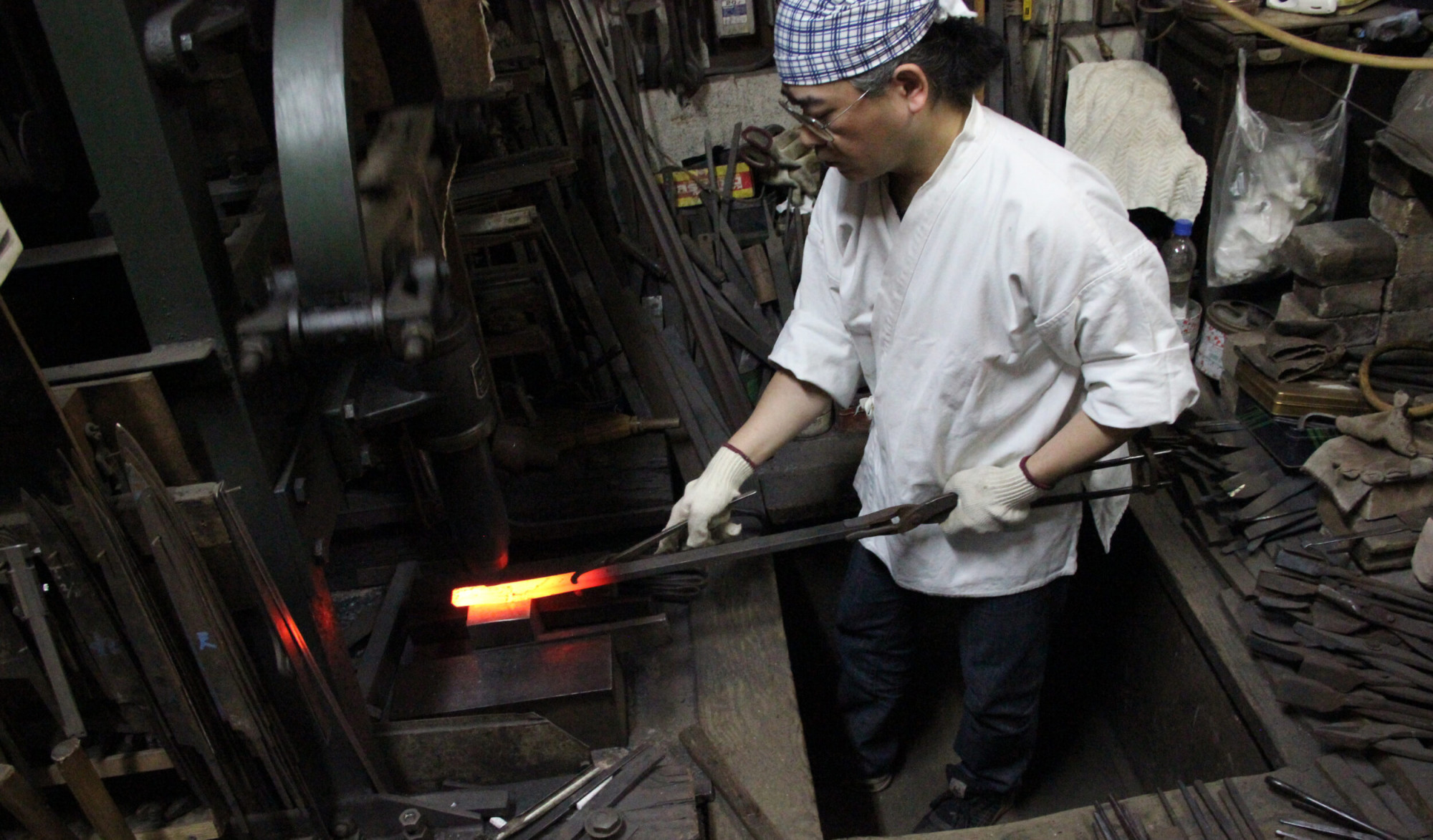
Sakai Kyuba 堺久馬 ist der Name unserer Linie japanischer Küchenmesser. Hinter der Marke Sakai Kyuba verbirgt sich die Kunstfertigkeit eines der berühmtesten Klingenmeisters in Sakai (Präfektur Osaka), Japan, der auf eine über 600 Jahre alte Schmiedetradition zurückblicken kann.
Obwohl von einer über 600 Jahre alten Tradition inspiriert, wird bei Sakai Kyuba nichts dem Zufall überlassen. Jede einzelne Klinge wurde in Japan von Sakais(堺市) Meisterschmied in sorgfältiger Handarbeit gefertigt und perfektioniert. Jede Klinge wird dann in Japan von Meisterschwertkämpfern geschmiedet und von Hand poliert, wobei sie Techniken anwenden, die von ihren Familien über Jahrhunderte hinweg perfektioniert wurden. Der Griff und die Klinge sind satiniert und haben einen subtilen, aber beeindruckenden Glanz. Hergestellt aus hochwertigem, 46-lagigem, gehämmertem Edelstahl AUS10 – stabiler und schärfer als alles, was Sie bisher erlebt haben. Handgefertigt, nicht hergestellt. Kein Griffmuster gleicht dem anderen, was Ihnen ein einzigartiges Stück Handwerkskunst garantiert.
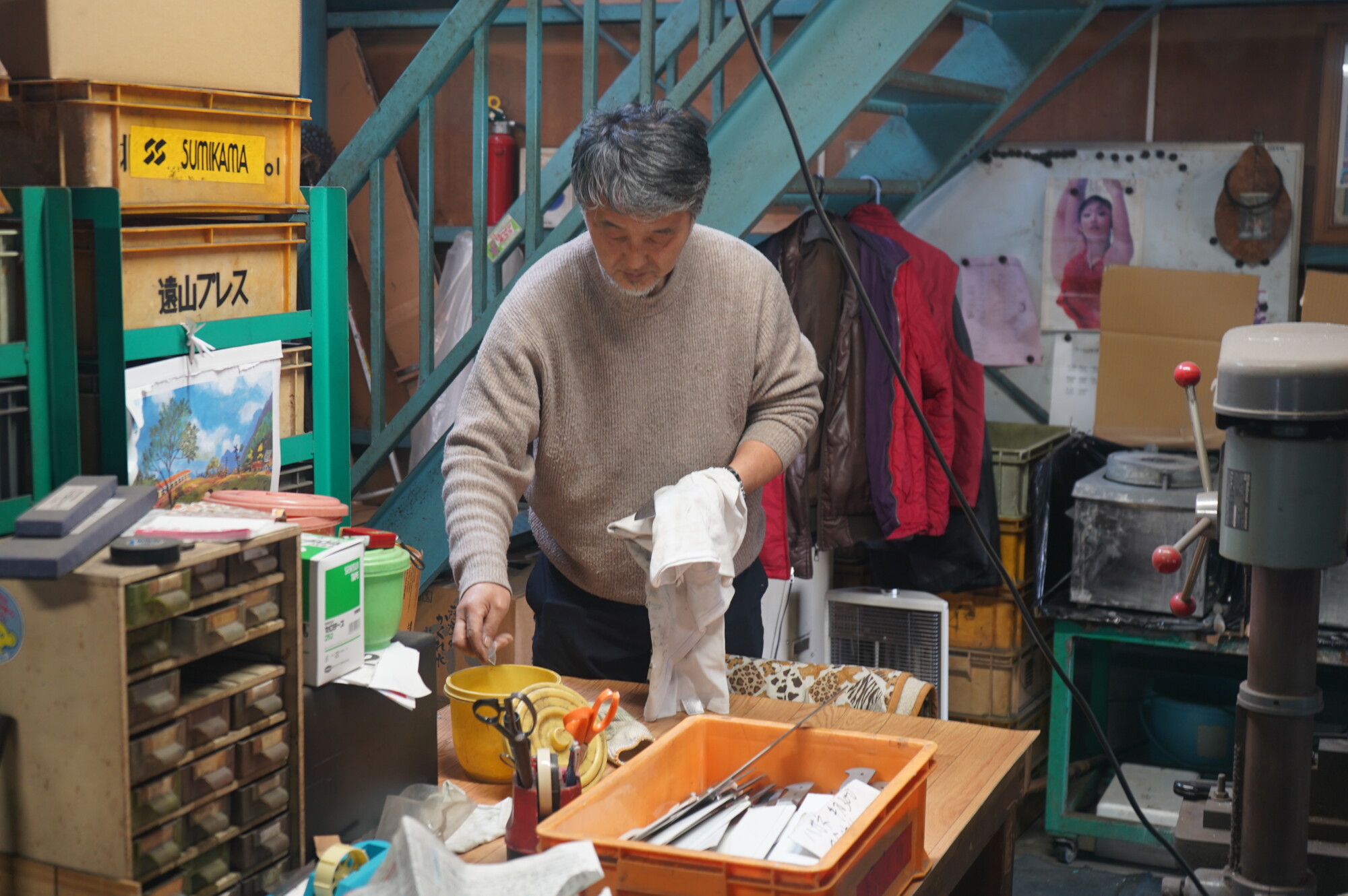
Die Geschichte unserer Seki Kyuba (席 急場) Messer beginnt in der historischen Stadt Seki in der Präfektur Nagano, wo die Traditionen der japanischen Klingenherstellung bis ins 12. Nach jahrelanger Suche haben wir einen außergewöhnlichen Schmiedemeister gefunden, der sein Handwerk seit 1975 perfektioniert hat. Seine Philosophie deckt sich wunderbar mit der unseren – jahrhundertealte Traditionen zu ehren und gleichzeitig innovative Techniken anzuwenden, um wirklich außergewöhnliche Messer herzustellen.
Zwar können wir seinen Namen aufgrund regionaler Exklusivitätsvereinbarungen nicht nennen, aber seine Kunstfertigkeit spricht aus jeder Klinge, die er herstellt. Er ist in ganz Japan dafür bekannt, dass er Messer für jeden kreiert, vom passionierten Hobbykoch bis zum weltberühmten Chefkoch, und er bringt seine jahrzehntelange Erfahrung in jedes Stück ein. Um jedes Messer noch spezieller zu machen, arbeiten wir mit erfahrenen europäischen Kunsthandwerkern zusammen, die unsere unverwechselbaren farbigen Ahornmasergriffe herstellen und so eine einzigartige Verbindung von japanischer und europäischer Handwerkskunst schaffen.
Japanische Messer müssen bei regelmäßigem Gebrauch zu Hause alle 2-3 Monate geschärft werden, oder wenn Sie eine nachlassende Schneidleistung feststellen. Im Gegensatz zu westlichen Messern profitiert japanischer Stahl eher von häufigem leichten Schärfen als von seltenem starken Schärfen.
Für Anfänger: Beginnen Sie mit unserer Schleifsteinkombination mit 1000/4000er Körnung. Die 1000er-Körnung eignet sich für die regelmäßige Pflege, während die 4000er-Körnung für das Polieren und die Feinarbeit an der Schneide sorgt.
Schärfvorgang: Weichen Sie die Steine 10 Minuten lang ein, halten Sie einen konstanten Winkel von 15-20 Grad ein und üben Sie leichten Druck mit gleichmäßigen, ruhigen Bewegungen aus. Üben Sie an weniger teuren Messern, bevor Sie Ihr japanisches Messer schärfen.
Professionelle Option: Wir empfehlen, die Messer alle 6-12 Monate professionell schärfen zu lassen, um eine optimale Leistung zu erzielen, insbesondere bei teuren Messern oder unerfahrenen Benutzern.
“Wie lagere und reinige ich mein japanisches Messer richtig?
Tägliche Reinigung: Waschen Sie das Messer sofort nach dem Gebrauch von Hand mit warmem Wasser und milder Seife. Vor der Lagerung vollständig trocknen lassen, um Rost und Schäden an Klinge und Griff zu vermeiden.
Aufbewahrungsmöglichkeiten: Verwenden Sie unsere magnetischen Holzständer, an der Wand befestigte Magnetleisten oder Messerblöcke. Vermeiden Sie die Aufbewahrung in losen Schubladen, da dies die Klinge beschädigen kann.
Pflege der Griffe: Unsere Griffe aus Mooreiche und Ahorn sollten alle 3-6 Monate mit lebensmittelechtem Mineralöl behandelt werden, um das Aussehen zu erhalten und Risse zu vermeiden.
Niemals verwenden: Spülmaschinen, Scheuermittel oder längeres Einweichen, da diese sowohl die Klinge als auch das Griffmaterial beschädigen können.
Not currently, but we’re developing a gift card programme. Subscribe to our newsletter to be notified when gift cards become available. In the meantime, if you’re buying a gift and would like to include a personal message, let us know at checkout.
Our current range offers three handle colours across all lines, which covers most preferences. We don’t usually offer custom configurations beyond these options, but feel free to email us and in specific cases we may be able to help.
We are exploring limited edition runs and special collaborations. If you’re interested in being notified about special releases, subscribe to our newsletter or email us at info@oishya.com to express your interest.
Contact us immediately at info@oishya.com if you need to modify or cancel an order. If we haven’t yet processed and dispatched your order, we can usually accommodate changes or cancellations. We aim to dispatch orders within 1-2 business days, so time is of the essence.
Once an order has been dispatched, we cannot cancel it, but you can return it under our 100-day return policy once it arrives.
Contact us immediately at info@oishya.com with your order number and the correct address. If your order hasn’t dispatched yet, we can update the address. If it has already dispatched, we’ll work with the courier to attempt an address correction, though we cannot guarantee success.
If the parcel is returned to us due to an incorrect address you provided, we’ll contact you about re-shipping. You’ll be responsible for the additional shipping cost for the second delivery attempt.
Unfortunately, once an order is placed, we cannot add items to it. You’ll need to place a second, separate order for additional items. Both orders can be shipped together if they’re processed at the same time, but we cannot guarantee this.
🚚 Shipping And Delivery
Yes, we offer free shipping on qualifying orders: free UK shipping for orders over £90, and free worldwide shipping for orders over £270 (or currency equivalent in euros or dollars).
For orders below these thresholds, standard shipping rates apply and are calculated at checkout based on your location and the weight of your order.
We ship worldwide. We currently dispatch from the UK, with reliable courier services to Europe, North America, Asia, Australia, and most other international destinations. We’re in the process of establishing a fulfilment centre in the European Union to improve delivery times and simplify customs for our EU customers.
Delivery times vary by destination. UK orders typically arrive within 2-5 business days after dispatch. European orders take 5-10 business days. For the rest of the world, expect 7-15 business days.
These are estimates from the date of dispatch, not from the date of order. We aim to dispatch orders within 1-2 business days of receiving them. During peak periods (such as the weeks before Christmas), both dispatch and delivery times may be slightly longer.
Once your order is dispatched, you’ll receive an email with tracking information and a link to track your parcel. You can also track your order by logging into your account on our website (if you created one) or using the “Track My Order” link in our website footer.
Tracking information typically becomes active within 24 hours of dispatch as the parcel enters the courier’s system. If you haven’t received tracking information within 48 hours of ordering, contact us at info@oishya.com.
Yes, there’s a notes field at checkout where you can provide delivery instructions such as “leave with neighbour at number 12” or “delivery after 2pm preferred”. However, we cannot guarantee that all instructions will be followed – this depends on the courier and the specific delivery driver.
For UK deliveries, most couriers offer a “safe place” option where you can specify a location for parcels to be left if you’re not home. Check your tracking link for these options, which usually become available on the day of delivery.
This depends on the courier and your location. Most UK couriers will attempt delivery, leave a card, and either reattempt the next day or allow you to collect from a local depot. Some couriers will leave parcels in a safe place if you’ve specified one.
For international deliveries, procedures vary by country and courier. Check your tracking information for specific details and options.
If multiple delivery attempts fail and the parcel is returned to us, we’ll contact you to arrange redelivery. Additional shipping charges may apply.
This depends entirely on your country’s import regulations, which are beyond our control. UK customers pay no customs duties or VAT.
For EU customers, we may be able to ship from within the EU to avoid customs complexities – contact us prior to placing order.
If not possible, you may be responsible for import VAT and duties when your parcel enters your country. These charges are collected by the courier or customs authority, not by us.
For customers in other countries, you may be responsible for import duties, taxes, and customs fees according to your local regulations. We recommend checking your country’s customs policies for importing goods before ordering. We mark all parcels honestly with their value – we cannot mark items as gifts or undervalue them to avoid customs.
Contact us immediately at info@oishya.com with photos of the damage (both to the knife and the packaging). Don’t discard the packaging – we may need it for insurance claims.
We’ll arrange a replacement or full refund promptly. All our shipments are fully insured, and we want to ensure you receive a perfect knife. Damage in transit is rare due to our robust packaging, but when it happens, we make it right quickly.
International parcels sometimes have gaps in tracking updates, particularly when passing through customs or being handed between courier networks. If tracking hasn’t updated for 3-4 business days (or longer for international orders), contact us at info@oishya.com with your order number. We’ll investigate with the courier.
For UK orders, tracking should update regularly. If it doesn’t, we’ll look into it immediately.
Contact us at info@oishya.com with your order number. We’ll investigate with the courier and resolve the situation. Delays are uncommon but can occur due to courier issues, weather, customs processing (for international orders), or other factors beyond our control.
We’ll work with you to either locate your parcel or send a replacement. Your satisfaction is paramount.
🔄 Returns And Exchanges
We offer a generous 100-day trial period. If you’re not completely satisfied with your knife, you can return it for a full refund or exchange, provided it’s in original, unused condition with all packaging, accessories, and documentation.
The knife must be genuinely unused – we cannot accept returns of knives that have been used for food preparation. The blade should be in the condition it arrived, without scratches, marks, or any sign of use. The edge should be factory-sharp, not sharpened or honed.
This policy allows you to receive the knife, handle it, examine it, and even test the weight and balance against produce (just don’t actually cut anything). It’s about ensuring you’re confident in your purchase without the pressure of an immediate commitment.
Email us at info@oishya.com with your order number and reason for return. We’ll provide return instructions and a return authorisation number. Do not send items back without contacting us first – returns without authorisation may not be processed correctly.
Pack the knife securely in its original packaging (box, wrapping, all accessories). Use a tracked, insured shipping method for your protection. Once we receive and inspect the return, we’ll process your refund within 3-10 business days.
For change-of-mind returns (you’ve simply decided you don’t want the knife, or you’d prefer a different style), you’re responsible for return shipping costs.
If the knife arrived damaged, defective, or we sent the wrong item, we’ll provide a prepaid return label and cover all shipping costs both ways.
Yes, exchanges are welcome. Email us at info@oishya.com to discuss your exchange. You’ll need to return the original knife (following the return process), and we’ll send the replacement once we’ve received and inspected the return.
If there’s a price difference between the knives, we’ll either refund the difference or invoice you for the additional amount. You’re responsible for return shipping on exchanges unless the original knife was defective or incorrect.
If you’ve recently purchased an individual knife and now want to complete the set, contact us at info@oishya.com. Depending on how recently you purchased and which knives you need to complete the set, we may be able to offer an accommodation. We handle these requests on a case-by-case basis.
🏢 About Oishya
We took inspiration from the Japanese word “oishii” (美味しい), which is often mistranslated simply as “delicious”. In reality, oishii describes an enjoyable experience connected with eating or drinking – the wonderful feeling of sharing a meal with friends, the satisfaction of a perfectly prepared dish, the pleasure of flavours that delight your senses.
To us, Oishya captures this broader meaning. It’s about enjoying the entire experience of making a home-cooked meal, from the moment you pick up your knife to the instant you taste the finished dish. It’s about creating joy, not just food.
We believe you deserve kitchenware that makes cooking tasks easier and more enjoyable. Life is too short for tools that frustrate you or break after a season. Our mission is to offer products crafted with the highest quality materials, so they’re made to last and used to create joy.
But it goes deeper than that. We’re building a community around values that matter: independence and self-fulfilment, finding life balance without neglecting wellbeing, enjoying the moment rather than rushing through it. We draw inspiration from Japanese concepts like ikigai (finding your purpose), kaizen (continuous improvement), and wabi-sabi (embracing imperfection).
We stand against disposable fashion. Against the throwaway culture that treats everything as temporary. We want to make a difference by offering everlasting, high-quality kitchenware that becomes part of your family story.
Sustainability isn’t just about materials – it’s about longevity. Our knives are built to last generations, not years. With proper care, a knife you buy today will serve your children and perhaps their children. This radical longevity is the most sustainable approach possible – one knife over fifty years instead of ten knives over fifty years.
We don’t use ready-made components or mass production. Each knife is forged by hand using traditional techniques, which supports cultural heritage and artisan craftsmanship rather than factory production. The materials are premium and durable – high-carbon steel, stabilised wood, proper construction.
We also personally oversee the end-to-end crafting process, working directly with blacksmiths in Japan and handle makers in Europe. There are no murky supply chains or unknown production conditions.
Finally, our lifetime warranty ensures these knives stay in use. If something goes wrong, we fix it. We want your knife to become a treasured tool, perhaps even an heirloom, not something that ends up in landfill.
Our blades are forged in two legendary Japanese knife-making regions. The KYU line is crafted in Sakai, near Osaka, which has been the traditional centre of Japanese kitchen knife production for over 600 years. The KATA, RYU, NIJI, SHIN, and PAN lines are made in Seki, Gifu Prefecture, which has been Japan’s premier sword and knife-making centre since the 13th century.
The handles are crafted in Europe using premium stabilised maple burl wood. This East-meets-West approach combines the best of Japanese blade-making tradition with European woodworking expertise.
Each knife is then assembled, inspected, and packaged with care before making its way to you.
Who are your craftsmen?
Our knives are forged by master blacksmiths who have inherited centuries of blade-making knowledge. In Sakai, the tradition of kitchen knife making goes back 600 years to when the region produced tobacco knives for Portuguese traders. In Seki, the sword-making tradition dates to the Kamakura period (1192-1333), when the region’s iron sand, pure water, and charcoal made it ideal for producing legendary blades.
These aren’t factories with assembly lines. They’re workshops where craftsmen who have spent decades perfecting their skills forge each blade using techniques passed down through generations. The forging, folding, heat treatment, and finishing are done by hand, by people who take immense pride in their work.
We work directly with these craftsmen, ensuring fair compensation and maintaining relationships built on mutual respect and shared commitment to quality.
Japanese blade-making represents centuries of accumulated knowledge and specialisation. The combination of high-carbon steel expertise, precise heat treatment, and traditional forging techniques creates knives that simply perform differently from Western knives. No other knife-making tradition has developed the same level of specialisation in kitchen knives.
That said, we incorporate European craftsmanship through our handles, which are made from stabilised maple burl in Europe. We’re not about Japan versus the West – we’re about bringing together the best of both traditions.
Oishya was founded by women who noticed a peculiar gap in the market. High-quality Japanese kitchen knives were almost exclusively marketed to men, positioned as “boy’s toys” or professional tools. Yet women make the vast majority of household purchasing decisions and do most of the cooking in homes across the UK and beyond.
We wanted to create a brand that celebrates both the functionality and beauty of Japanese knives, without the gendered marketing. A brand that understands that tools can be gorgeous and well-crafted whilst being serious, professional-grade equipment. That kitchenware can spark joy whilst performing flawlessly.
We also wanted to build something beyond transactional retail – a community of people who value mindful living, quality over quantity, and the quiet satisfaction of doing something well. Cooking with a beautiful knife that will last generations aligns perfectly with these values.
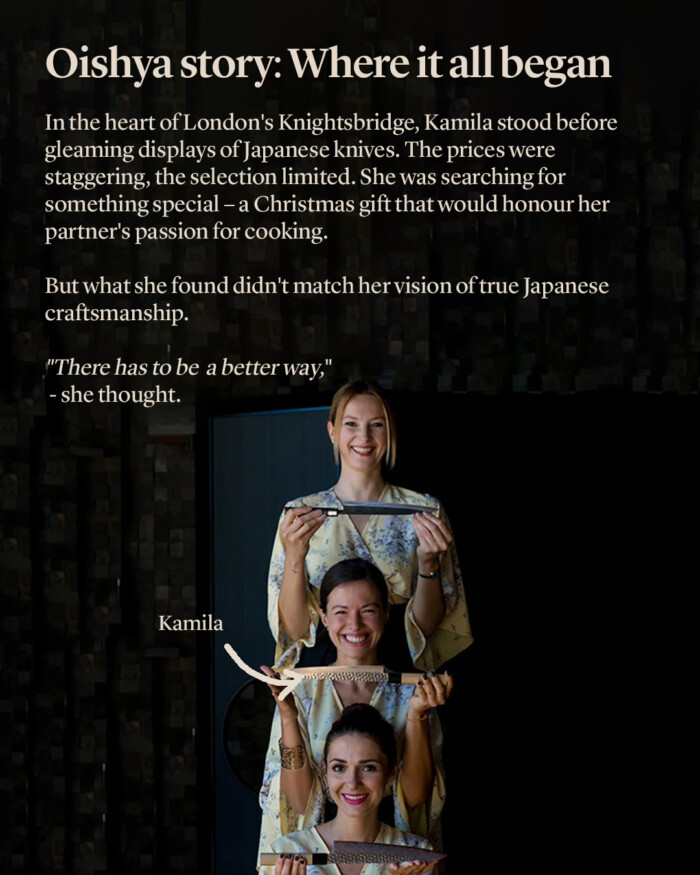
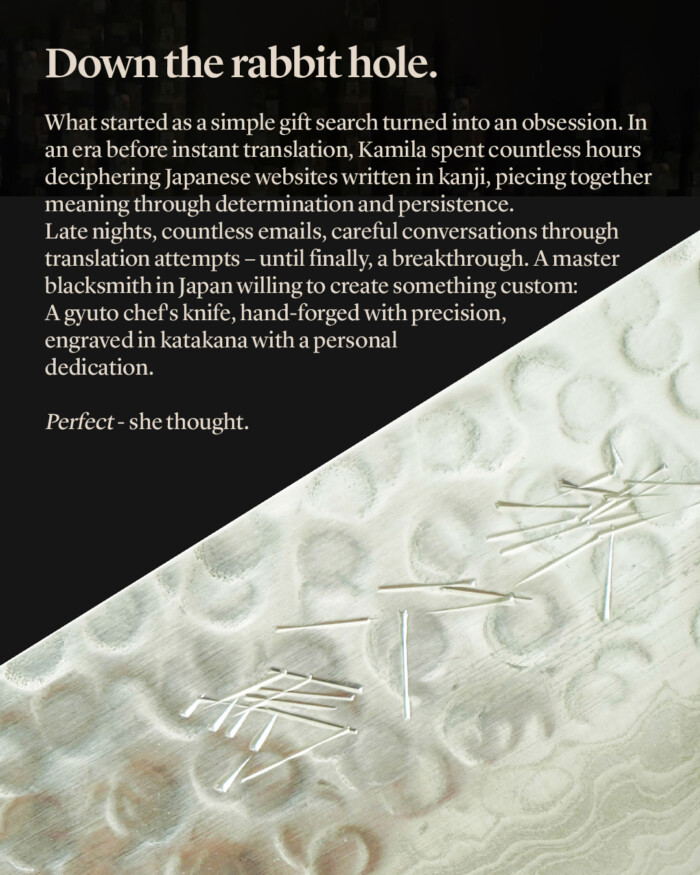
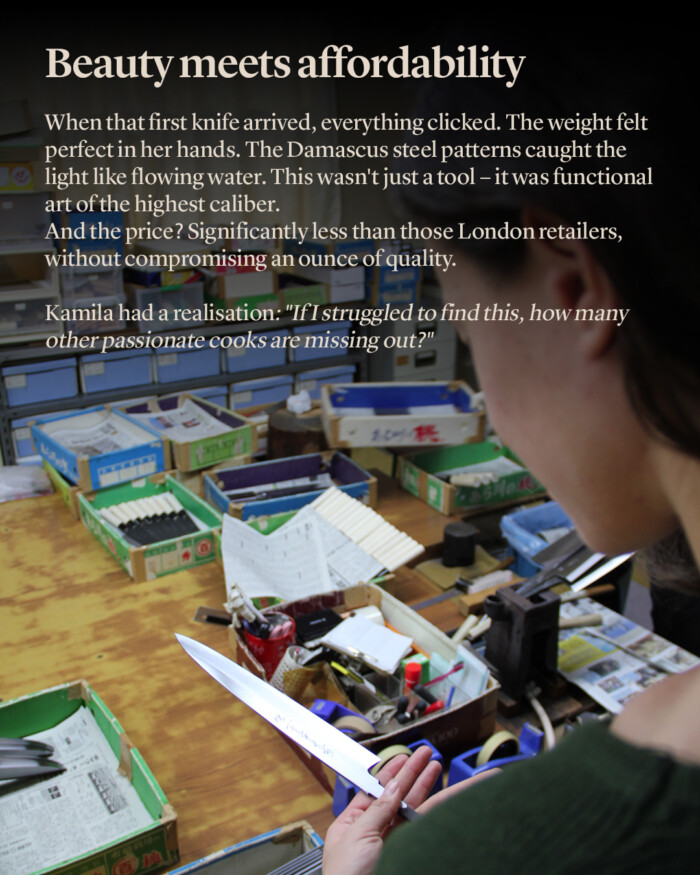

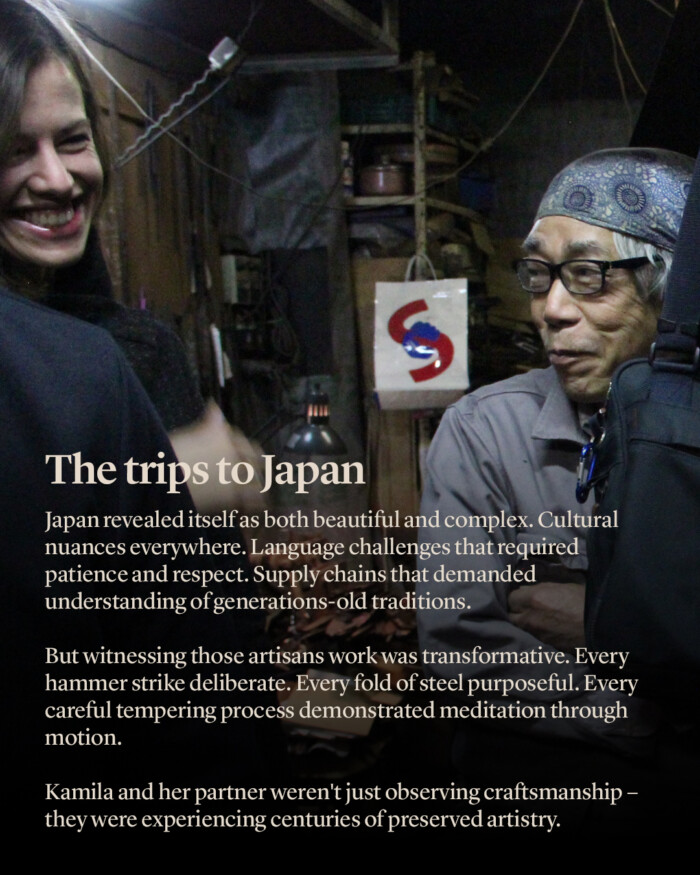
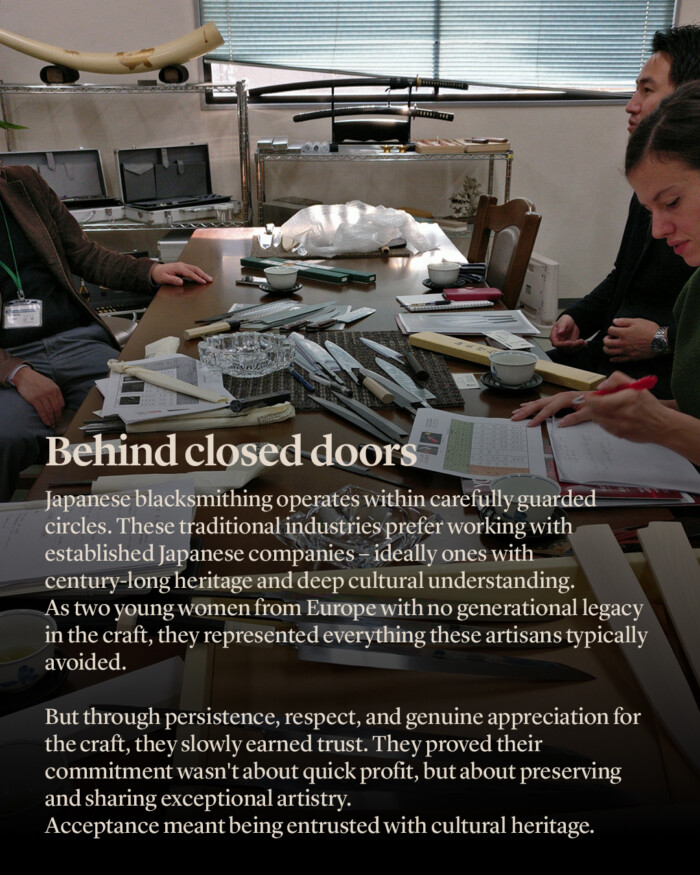
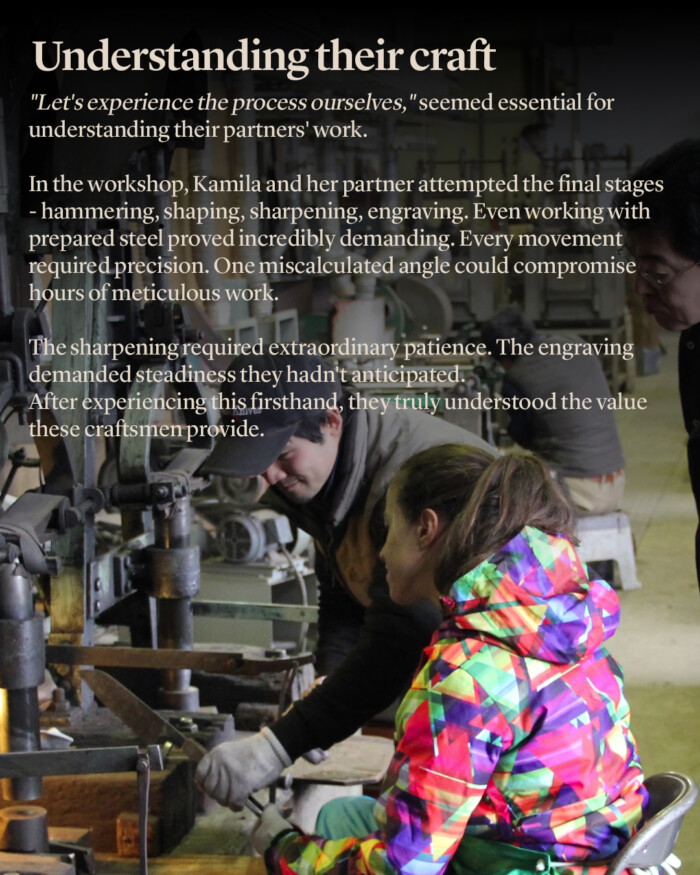
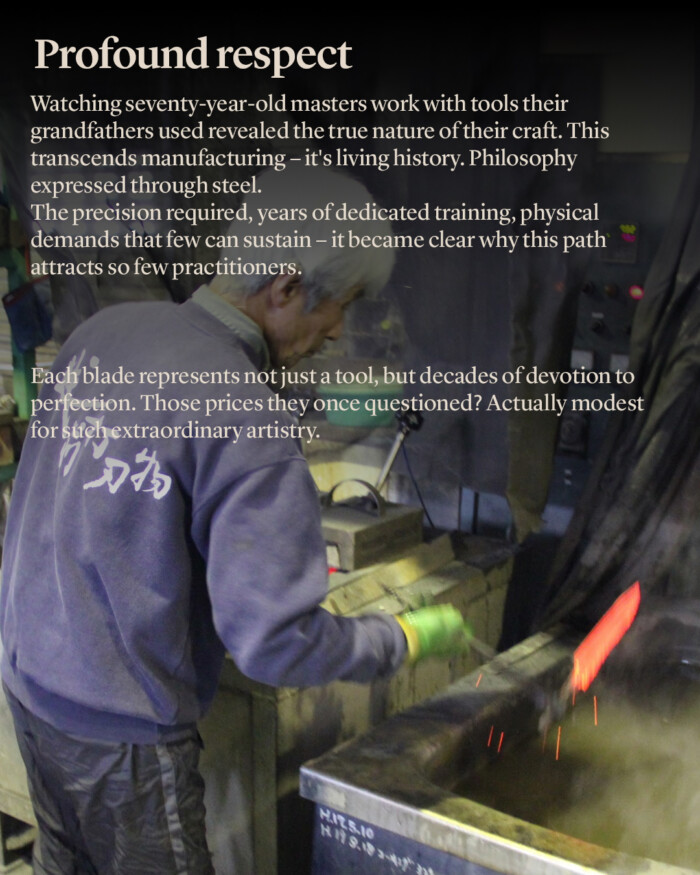




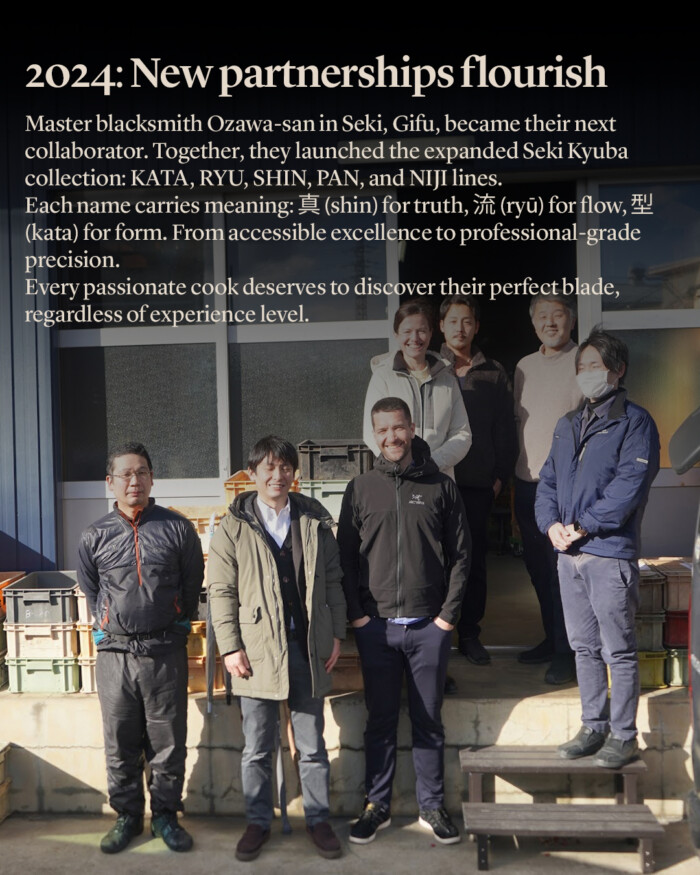
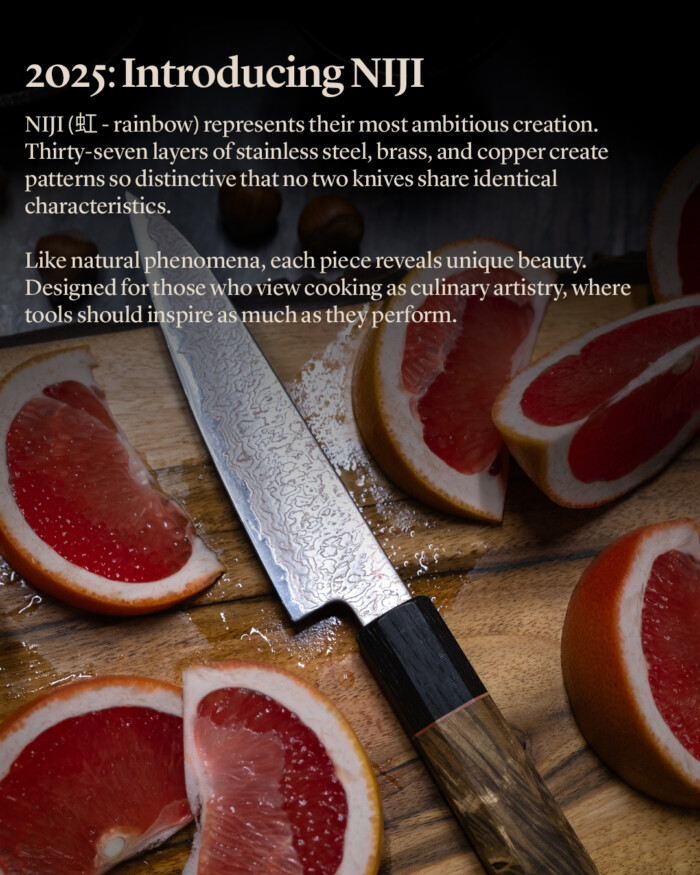


Our craftsmen and blacksmiths

Sakai Kyuba 堺久馬 is the name of our line of Japanese kitchen knives. Under the Sakai Kyuba brand lies the artistry of one of the most famous blade masters in Sakai (Osaka Prefecture), Japan, drawing from over 600 years old blacksmithing tradition.
Although inspired by over 600 years of tradition, nothing about Sakai Kyuba is left to chance. Every single blade has been meticulously handmade and perfected in Japan by Sakai’s (堺市) master blacksmith. Each blade is then forged and hand-polished in Japan by master swordsmen using techniques perfected by their families over centuries. The handle and blade are satin-finished to a subtle, yet stunning lustre. Made from the highest quality AUS10 46-layer Damascus Hammered Stainless steel – sturdier and sharper than anything you have experienced before. Crafted, not manufactured. No handle pattern is the same, guaranteeing you a unique piece of craftsmanship.

The story of our Seki Kyuba (席 急場) knives begins in the historic city of Seki, Gifu prefecture, where Japanese blade-making traditions date back to the 12th century. After years of searching, we found an extraordinary master blacksmith who has been perfecting his craft since 1975. His philosophy beautifully aligns with ours – honouring centuries-old traditions while embracing innovative techniques to create truly exceptional knives.
Whilst we cannot share his name due to regional exclusivity agreements, his artistry speaks through every blade he crafts. Known throughout Japan for creating knives for everyone from passionate home cooks to world-renowned chefs, he brings decades of expertise to each piece. To make each knife even more special, we collaborate with skilled European artisans who craft our distinctive colourful maple burl handles, creating a unique fusion of Japanese and European craftsmanship.